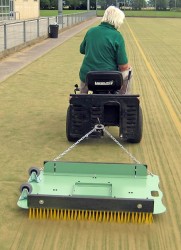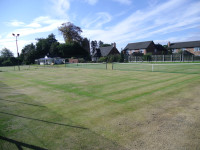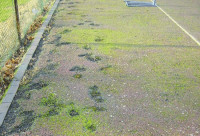Key Tasks for September
General Maintenance

A soil analysis will determine a number of factors to help you decide on the appropriate treatments and choice of materials required for your end of season renovations.
By taking a soil sample, you can also identify the amount of thatch present. This will help you decide on the level of scarification required. One of the biggest problems during renovations is the fact that many clubs do not remove enough thatch from their swards. This is often due to either not enough passes with the scarifier at the correct depths, or using a machine that is not robust enough or engineered to cope with the work required.
Other important tasks:
- Ensure all materials (seed, fertilisers, topdressings) and any hired machinery have arrived, and are secured and stored safely on site ready for use. Often, when ordering materials late, you may be faced with delays on delivery or not being able to get the products you want in time for your planned works.
- Continue with weekly or twice weekly mowing regimes to maintain sward height.
- Maintain turf vigour and colour with an application of an autumn fertiliser.
- Once the playing season is over, take down nets and posts and store away, replacing any broken or damaged equipment.
- Get organised for your end of season renovations, ensure you have ordered your materials to arrive on time. Check equipment, ensuring it is ready for the work entailed. Check all belts and drives on the scarifiers.
- If you are intending to use a contractor to do your work, confirm start dates and be clear they understand what level of work you want.
- Arrange to have your mowers serviced during the winter months.
Renovations

Depending on the severity of the thatch, you may need to scarify several times in different directions. However, in most cases, if regular verticutting/grooming has taken place during the growing season, you would probably only be required to scarify in two directions. Do not scarify at right angles to the previous scarification line. Depth of scarification between 4-15mm depending on depth of thatch to remove.
In recent years, we have seen a number of clubs fraise mowing the courts to remove surface vegetation. This method is more thorough and helps restore levels, however it comes at a higher cost than traditional scarifying methods.
Blowers / vacuums / power brushes and mowers can be used to clean up the courts after scarifying has been completed.
Aeration. Aerate to relieve compaction and encourage root development. Aeration is the decompaction of soil, improving air and gas exchange in the soil profile. Depending on the turf's condition, you can choose to carry out hollow or solid tine spiking.
Hollow tines are generally used on a bi-annual basis or when you have a severe thatch problem. Depth of aeration will be determined by the depth of your soil profile and what problems you want to rectify. Hollow tining is best achieved to a depth of between 75-100mm. Solid or slit tines can be set to penetrate deeper, ideally between 100-200mm.
Topdressing restores levels and improves surface drainage. Ensure you use compatible topdressing materials, sands, sand/soil mixes. Spreading can be achieved by several methods, utilising pedestrian or ride on disc or drop action top spreaders, or by hand using a shovel and a barrow. Best carried out in dry weather. It is important that the topdressings are spread uniformly.
Overseeding restores grass populations. It is important to ensure a good groove or hole is made to receive the seed; good seed to soil contact is essential for germination. Good moisture and soil temperatures will see the seed germinate between 7-14 days. Invest in good seed varieties, do not compromise the hard work by buying cheap grass seed, have a look at the current Turf Grass Seed Guide and see what varieties are recommended for Tennis.
Fertilising provides nutrients for grass growth. Apply a low N nitrogen fertiliser product something like an NPK 5:5:15 to help the sward through the autumn period.
Brush to incorporate dressings and to help the grass stand back up. Brush in with a lute or drag brush/mat to restore levels.
It is essential to keep the sward watered after renovations to ensure your seed germinates.
Other Surfaces

Artifcial courts. Spend time cleaning and maintaining your artificial playing surfaces, they are not maintenance free and require appropiate attention to keep them clean, safe and playable. We now have a lot of different playing surfaces to manage, so consult manufacturer's guidelines and regularly inpect and maintain these surfaces.
Inspect fencelines, net posts and netting. Also check floodlighting; you should have the lights inspected and certified for use annually.
Keep surfaces clean with regular sweeping and brushing. Remove any algae and moss from surface. Sand filled systems require regular brushing to maintain manufacturer's recommendations on sand levels and pile heights..
American Fast Dry courts. Keep surface clean, rolling to consolidate surface, levelling and brushing of fast dry materials, brushing to clean lines.
Clay courts. Keep surface clean, regular sweeping and brushing to restore playing levels using SISIS Trulute or similar equipment. Topdress any hollows or damaged areas. Repaint lines.
Tarmacadam. Keep surfaces clean, regular sweeping and brushing. Repair any hollows or damaged areas. Repaint lines.




Traditionally, the good levels of available moisture, coupled with adequate warmth at this time of the year, make it the perfect window to successfully germinate and establish seed. Getting young seedlings off to a good strong start is important in terms of maximising establishment prior to the onset of winter.
Yet again, humates are strong in this regard with the increased nutritional availability, hormones synthesis and bacterial promoting benefits all contributing to generate real gains in post germination establishment. A high quality pressure extracted humate with a natural pH of just above 4 will give the best results; and with lower application rates, typically from around 5-10 L/ha with the advantages a natural pH affords, such products are a very affordable and justifiable expense for sports clubs of all disciplines and levels.
If you have not yet taken the plunge with humates, and for that matter seaweeds and carbon sources, then I would go as far as to say you really are missing a massive, cost effective trick.
If you do what you always do, you’ll get what you always got: A common phrase often attributed to many principles. In this instance. the subject for reappraisal is iron sulphate: for years applied to turf surfaces prophylactically throughout the autumn and winter as a turf hardener, with the intent of helping the turf resist the rigours of the winter climate and fungal disease by thickening cell walls.
Perceived wisdom which holds no truth in scientific reality.
Iron has no involvement in the thickening of plant cell walls; for that, you need calcium. Furthermore, the acidic nature of Iron sulphate will actually act to weaken plant cell wall structure. The unsuitability of Iron sulphate for this purpose was shown in disease trials in autumn 2016, where prophylactic applications of iron sulphate statistically performed no better in controlling disease concentrations around 35-40%. Curative applications of iron sulphate produced a 50% reduction in disease concentration, but you’ve then got the problem of reduced leaf integrity due to the acidic action.
In this instance, use phosphite, which stimulates plant protection without simultaneously making it more susceptible to further infection.
These research findings concur with the message we at Pitchcare have been recommending for some time, which is:
- Do not use iron sulphate to harden turf against disease
- Use foliar calcium in combination with phosphite and potassium silicate
- To promote colour, use a 100% chelated iron (worth asking the question: how much is chelated, as most are not 100% and contain some iron sulphate) or, alternatively, consider applications of magnesium
If you are going to apply iron sulphate, then do so in the spring to control moss when temperatures are too low for bacterial moss treatments to work effectively, and the sulphate will promote early season plant metabolic function.
In terms of general nutrition, then September is still not too late for an organic based fertiliser, with longevities of up to eight weeks, this should see you through to the end of autumn.
July through August witnessed high disease pressure due to prolonged humidity driven by persistent rainfall and overcast days. During this period, diseases such as microdochium patch constantly bubbled away on fine turf surfaces, ebbing and flowing in the background to varying degrees of severity. Due to typically strong leaf growth through July and August, the grass is often able to outgrow the disease, preventing severe infection. However, as cooler nights in September cause soil temperatures to fall and growth rates to subsequently subside, the grass begins to lose any advantage.
The use of systemic active ingredients will be the only option once Iprodione - the active ingredient in Chipco and Interface - is most likely to be withdrawn in the next twelve months.
The new norm will be fungicides having to be applied prior to visible signs of disease, using cross referencing of historical outbreaks, weather forecasts and turf conditions to make informed decisions on the best timing. This latter approach is something which actually has the advantage of preventing early season scars, and the subsequent depositing of densely concentrated populations of fungal spores at their margins lying in wait for the slightest whiff of opportunity to fire back up and create ever expanding scars all winter long.
Now is the key time to apply entomopathogenic nematodes for the control of Leatherjackets and Chafer Grubs. Plenty of moisture both before and after application is the key to success, and the addition of a penetrant wetting agent will further aid results.
Please note: More information on these and many others can be found here: https://www.pitchcare.com/useful/diseases.php
- Keep machinery in good order, clean after use and top up any oil/fuel levels.
- Check cutting cylinders are at correct cutting height and are sharp.

We have one day LANTRA accredited LINEMARKING COURSES being held:
Wednesday 18th October, East Harling, Norwich, NR16 2NB
Some of the other courses available are:
- Chainsaws - CS30 and CS31
- H&S Refresher Training on Combined Turf Care Equipment; Tractors and Trailers; All Mowers (Ride-on and Pedestrian)
- Machinery Courses on ATVs; Tractors: Brushcutters/Strimmers; Mowers (ride-on and Pedestrian)
- Pesticide Application (PA courses)
- Stem Injection of Invasive Species (Japanese Knotweed etc.)
- Basic Trees Survey and Inspection
More details about all the courses can be found on our new Grounds Training website, or you can email Chris Johnson for information.


